How the Canaanites, Biblical frenemies of the Israelites, kept genetic integrity
Major study shows Canaanites maintained coherent genetic mix even though they were widely dispersed, and it can still be discerned in modern Arabic-speaking and Jewish populations
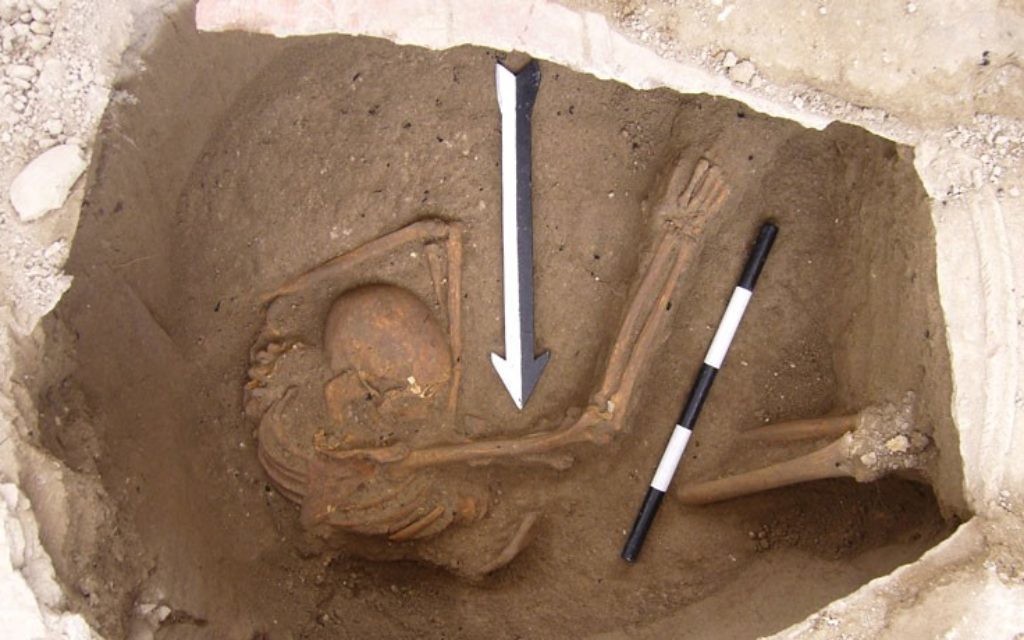 Illustrative: Burial of individual analyzed in the Canaanite study, from about 1600 BC. (Dr. Claude Doumet-Serhal/Wellcome Trust Sanger Institute)
Illustrative: Burial of individual analyzed in the Canaanite study, from about 1600 BC. (Dr. Claude Doumet-Serhal/Wellcome Trust Sanger Institute) Weapons and jewelry discovered at a 12th century BCE Canaanite temple at Lachish. (T. Rogovski)
Weapons and jewelry discovered at a 12th century BCE Canaanite temple at Lachish. (T. Rogovski)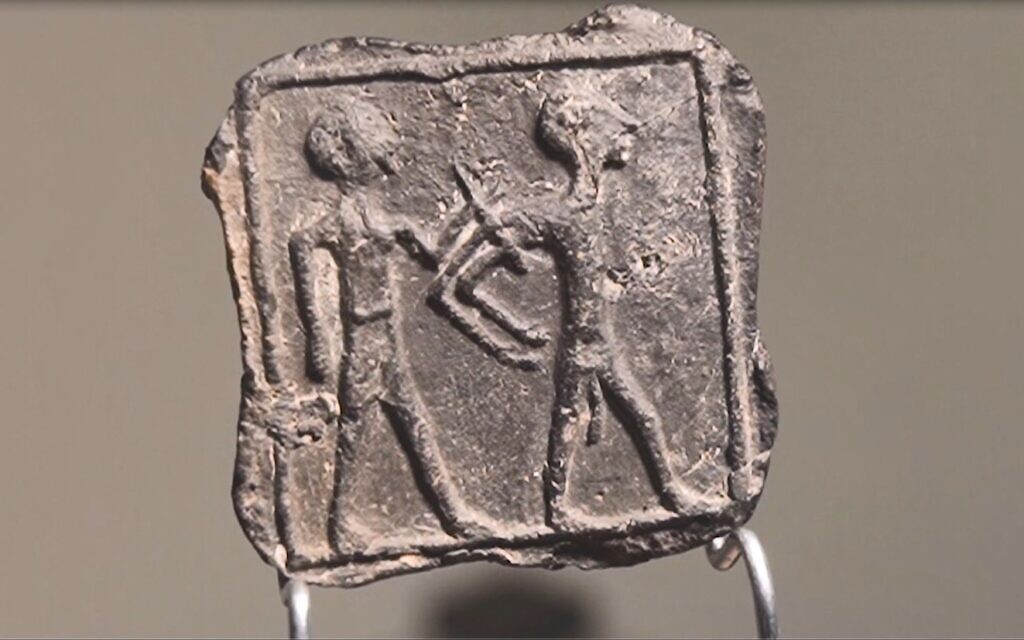 3,500-year-old Canaanite clay piece found on Tel Gama (the Canaanite city of Yarza), March 2020. (Emil Eljam/Israel Antiquities Authority)
3,500-year-old Canaanite clay piece found on Tel Gama (the Canaanite city of Yarza), March 2020. (Emil Eljam/Israel Antiquities Authority)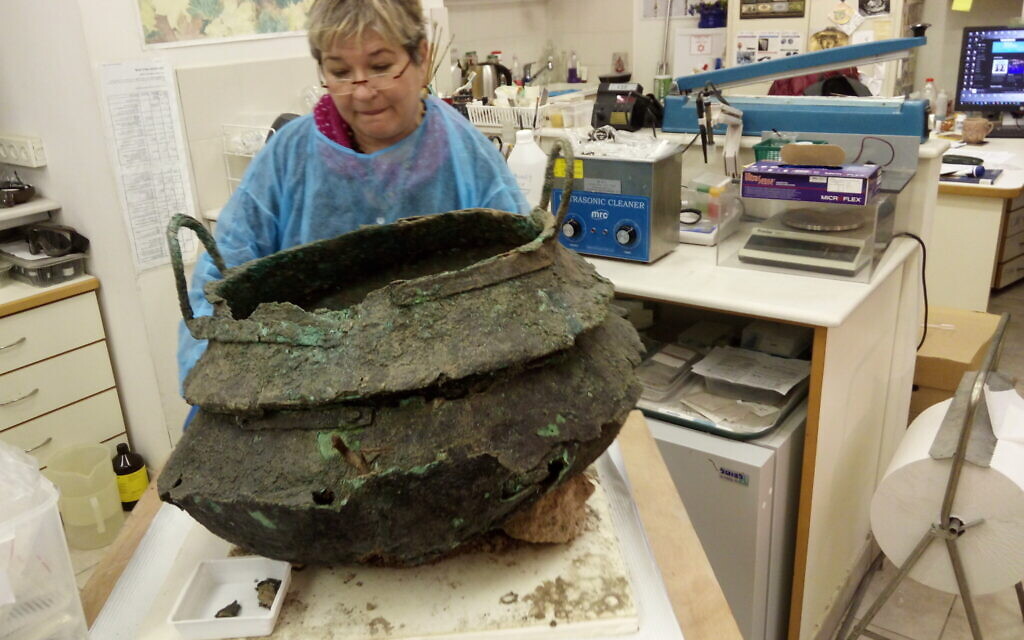 A conservationist works on a bronze cauldron found at a 12th century BCE Canaanite temple at Lachish. (T. Rogovski)
A conservationist works on a bronze cauldron found at a 12th century BCE Canaanite temple at Lachish. (T. Rogovski)
A new international, interdisciplinary study provides intriguing answers to the origins and history of the Canaanite people. In an article published May 28 in the prestigious peer-reviewed journal Cell, scientists report that over thousands of years, the widely dispersed Canaanite people maintained themselves as a demographically coherent group.
The study was performed through a genome-wide analysis of ancient DNA samples from the remains of 93 individuals at nine Bronze Age Canaanite sites throughout the Levant.
“The Canaanites, albeit living in different city-states, were culturally and genetically similar,” said Hebrew University ancient DNA specialist Liran Carmel.
For centuries, scholars have debated over who the Canaanites were and where they originated. Ancient “frenemies” of the conquering Israelites, the Canaanites were recorded throughout the Bible and in historical documents up to 3,500 years old as a group of peoples living throughout the Levant who were ruled by their own city/state kings.
The study also discovered that they shared a genetic relationship with another group of people who slowly and continuously migrated from the far-away Caucausus and/or Zagros Mountain regions. This special genetic mix of Canaanite and mountain peoples can still be seen in some form with modern Arabic-speaking and Jewish populations, wrote the authors.
“Our results in this new study show that the ‘Canaanite’ term that is known from the archaeological and historical literature in fact corresponded to a genetically mostly homogeneous group of people — it was not just a shared set of ideas, but a people of similar ancestry,” Harvard University Ancient Genetics Prof. David Reich told The Times of Israel on Thursday.
Data from DNA samples that came from 73 new individuals from five archaeological sites throughout the Southern Levant dating to the Middle-to-Late Bronze Age, was added to previously reported data from 20 individuals from four sites. The study was completed by a large interdisciplinary team, including University of Vienna biological anthropologist Ron Pinhasi, Hebrew University geneticist Shai Carmi, Tel Aviv University archaeologist Israel Finkelstein, Hebrew University’s Carmel, and Harvard’s Reich.
But while archaeological finds at identifiably Canaanite sites point to the far-flung peoples as having their own particular material culture, until now it was unknown whether they had a discernible genetic group as well.
The results of the Canaanite samples were cross-checked with other ancient peoples, including Philistine DNA from recent academic studies. Carmel, who researches ancient DNA and human evolution, told The Times of Israel, “we see that genetically, the Canaanites are more similar to each other than other groups in the region were to them.”
A continuous drip-drop of migration?
In the paper, “The Genomic History of the Bronze Age Southern Levant,” the authors write that they had three research goals in mind: “We sought to determine the extent of genetic homogeneity among the sites associated with Canaanite material culture. Second, we analyzed the data to gain insights into the timing, extent and origin of gene flow that brought Zagros- and Caucasus-related ancestry to the Bronze Age Southern Levant. Third, we assessed the extent to which additional gene flow events have affected the region since that time.”
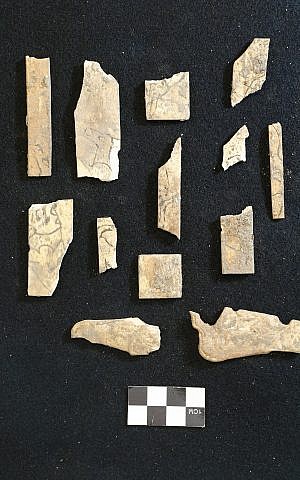
Carmel said that Bronze Age (circa 3500-1150 BCE) populations in the Southern Levant — today’s Israel, Jordan, Lebanon, and parts of Syria — were not static. “Rather, we observe evidence for the movement of people over long periods of time from the northeast of the Ancient Near East, including modern Georgia, Armenia and Azerbaijan, into the Southern Levant region,” he said in a Hebrew University press release on the new study.
In the Canaanite samples, Hebrew University Genetics Prof. Shai Carmi told The Times of Israel, “What we found is that the origins are a roughly equal mixture of people from the Caucasus/Zagros, along with local people from the Levant.”
Carmi said that according to the data, “there was migration from the Caucasus/Zagros into the Levant that has replaced some proportion of the population between 8000 and 3500 years ago (and possibly continued)… We showed that people migrated from the Caucasus/Zagros and assimilated (genetically) in the Levant. That is to say, they didn’t remain as an independent and distinct group but merged with the local populations.”
Carmi said scientists still don’t know the hows and whys of the migration based on the genetic data. “The process of mixing of populations was and still is very common across human populations,” said Carmi.
Hurrian ties and the color purple
A possible explanation of why the peoples may have continuously migrated to the Levant might be found in a theory on the Hurrian origin of the name Canaanite itself. Hurrian was a language spoken in the northeast of the ancient Near East, possibly including the Caucasus, according to the Cell article.

The entry for “Canaan/Canaanite” in the Bialik Institute’s comprehensive Encyclopaedia Biblica states the name may be related to purple dye. It writes that in the Nuzi Tablets, some 5,000 tablets found in modern Iraq mostly dating to the Hurrian period (15th century BCE), the Hurrian word “kinakhkhu” was used for the biblical purple color argaman, which is made from murex snails.
In a rather convoluted explanation, ties are made between this Hurrian word for “purple” to the ancient Greek word for the Levant, “Phoenicia,” which means “Land of Purple.” It also mentions ancient Egyptian correspondence speaking about the capture of purple dye merchants — the “kina’nu” — while Pharaoh was on tour in Syria in 1428 BCE.
According to the online Ancient History Encyclopedia, “…Theories cite ‘Canaan’ as derived from the Hurrian language for ‘purple’ and, as the Greeks knew the Canaanites as ‘Phoenicians’ (Greek for ‘purple’) and as the Phoenicians worked in purple dye and so were called by the Greeks ‘purple people,’ this explanation is the most probable.”
Assuming that the Canaanites were the “purple people,” or at least merchants for the very valuable purple dye, that may help explain the proliferation of Hurrian names of rulers in Canaanite settlements that are documented in the 2nd millennium BCE.

In samples taken from 35 individuals from Tel Megiddo (northern Israel), it was discovered that the influx of migration from the possibly Hurrian-speaking areas of the Zagros/Caucasus Mountains continued through a rise in the percentage of this foreign DNA in a few “outliers” found at the site.
“The Canaanite society of Megiddo was certainly tolerant of foreigners and immigrants, as shown by the several genetic outlier individuals we detect there,” said geneticist Carmi.
Archaeologist Finkelstein told The Times of Israel that these individuals were buried close to the palace in a tomb related to the fantastically preserved Canaanite “Royal Tomb” uncovered recently.
Asked about the reasons behind the migration, Finkelstein wrote in an email, “Why is a good question, to which, for the time being, we don’t have an answer.”
“We think that the origin of these people was the Caucasus. To just walk from there to Megiddo would take a long time, perhaps a month or more, but I don’t think that it worked that way. We are probably speaking about a gradual movement to the south, and one which continued ‘betiftufim; [in drips and drabs] for many centuries,” said Finkelstein.
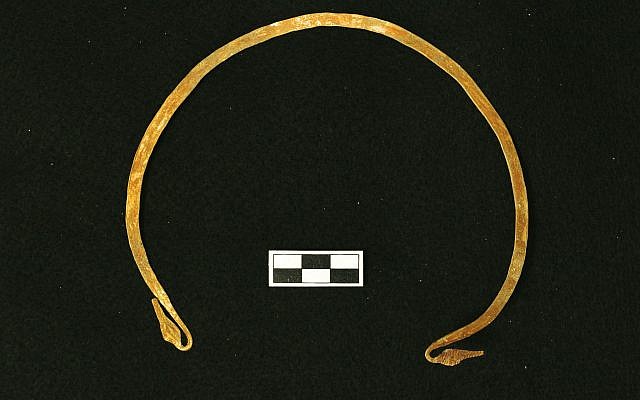
Finkelstein referred to Bronze Age archaeological evidence found in the Levant that tie the material culture of the Caucasus Mountain people to the Levant from the Early Bronze Age, including the Khirbet Kerak (Beth-yerah) vessels. “For later, in the second millennium, Hurrian names of local rulers in the [14th century BCE] Amarna tablets, including the name of the ruler (king) of the city-state of Megiddo – Biridiya.”
According to Carmi, “The strength of the migration from the northeast of the Ancient Near East, and the fact that this migration continued for many centuries, may help to explain why rulers of city-states in Canaan in the Late Bronze Age carry non-Semitic, Hurrian names… There were strong and active connections between these regions through movements of people that help to understand the shared elements of culture.”

A Hurrian/Canaanite diaspora?
In the article, the authors state, “We found that both Arabic-speaking and Jewish populations are compatible with having more than 50% Middle Eastern-related ancestry.” At the same time, the direct contribution of the Canaanites to modern populations cannot be accurately quantified, they write.
So there is some genetic tie between the Canaanites and modern Arabic-speaking and Jewish populations? Hebrew University’s Carmel laughed when asked if his research team’s methods would be available to those who, for example, want to check if they have Jewish ancestry.
“It would be a little bit of an overkill, to say the least,” he laughed, pointing the curious to the many online genetic testing sites available on the market.

Harvard’s Reich said that there are other examples in the ancient world of a dispersed, but culturally and genetically close people.
“The analogy I like is to two other famous ancient cultures that inhabited the eastern Mediterranean at around the same time as the Canaanites: (1) the people associated with the ‘Minoan’ culture of ancient Crete, and (2) the people associated with the ‘Mycenaean’ culture of ancient Greece,” said Reich. “Archaeologists studying the material remains these people left behind and the written records left by the Mycenaeans have put names on these ancient cultures, but there was always a question whether the material artifacts associated with these cultures were associated with homogeneous genetic populations.
“In 2017, we published a paper showing that in fact, ‘Minoans’ and ‘Mycenaeans’ each corresponded to a coherent and relatively homogeneous genetic cluster (which were different from each other and also different from people both to the east and the west in the Mediterranean),” wrote Reich in an email.

Talk of dispersed, but linked peoples brings to mind the idea of the Jewish Diaspora. Asked if the new study shows that the Canaanites were part of some similar type of diaspora stretching from the Caucasus Mountains, Hebrew University’s Shai Carmi demurred. “I’m not sure it’s really a diaspora. Maybe it’s more like Spanish people moving to the Americas a few hundreds of years ago and merging with the local populations,” said Carmi.
There are also modern-day examples of similar relationships, said Carmi. “For example, Ashkenazi Jews from all over the world are genetically very similar. Druze live in multiple countries in the Middle East but are genetically similar… African Americans have been in the US for hundreds of years, but the vast majority of their genetic ancestry is shared with West Africans,” said Carmi.
In general, people that lived thousands of years ago are remarkably similar to present-day people
As scientists are increasingly filling out the data set for ancient people’s DNA, one can only wonder if the differences between modern and ancient man are in any way remarkable. Apparently, that’s a matter of perspective.
“In general, people that lived thousands of years ago are remarkably similar to present-day people,” said Carmel. “If you go sufficiently back in time, for example to the adoption of agriculture in Europe, you may track changes in adaptive alleles such as lactose tolerance. But this doesn’t really apply to populations, such of those of the Bronze Age, which are very close in time to present-day populations.”
Are you relying on The Times of Israel for accurate and timely coverage right now? If so, please join The Times of Israel Community. For as little as $6/month, you will:
- Support our independent journalists who are working around the clock;
- Read ToI with a clear, ads-free experience on our site, apps and emails; and
- Gain access to exclusive content shared only with the ToI Community, including exclusive webinars with our reporters and weekly letters from founding editor David Horovitz.

We’re really pleased that you’ve read X Times of Israel articles in the past month.
That’s why we started the Times of Israel eleven years ago - to provide discerning readers like you with must-read coverage of Israel and the Jewish world.
So now we have a request. Unlike other news outlets, we haven’t put up a paywall. But as the journalism we do is costly, we invite readers for whom The Times of Israel has become important to help support our work by joining The Times of Israel Community.
For as little as $6 a month you can help support our quality journalism while enjoying The Times of Israel AD-FREE, as well as accessing exclusive content available only to Times of Israel Community members.
Thank you,
David Horovitz, Founding Editor of The Times of Israel










